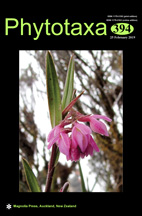Abstract
Stem anatomy of Bufonia and nine allied genera was studied in order to investigate the systematic value of anatomical characters in generic delimitation. Cross-sections of stems of 31 accessions representing 14 species and 3 subspecies of Bufonia, and 17 additional species of the genera Arenaria, Cerastium, Eremogone, Minuartia, Minuartiella, Odontostemma, Sabulina, Sagina, and Shivparvatia were examined using light microscopy. The characteristic features of stem anatomy in Bufonia are: 1) presence of one to four layers of parenchyma in cortex, 2) calcium oxalate crystals mostly in the endodermis, 3) presence of inner and outer sclerenchymatous pericycle, and 4) a large central pith rupturing in a linear to boat-shape mode and forming a central continuous slit. Characters such as arrangement and continuity of xylem along with the number, and arrangement of different tissues (or layers) discriminate Bufonia from the other studied genera. Stem anatomy of Eremogone, Minuartia, and Bufonia showed some degree of similarity reflecting a level of convergence in the stem anatomy that might explain the taxonomic confusion associated with this group. The present study supports previous exclusion of Bufonia koelzii and B. caespitosa from Bufonia and their inclusion in Eremogone.

